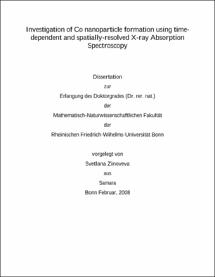Zinoveva, Svetlana: Investigation of Co nanoparticle formation using timedependent and spatially-resolved X-ray Absorption Spectroscopy. - Bonn, 2008. - Dissertation, Rheinische Friedrich-Wilhelms-Universität Bonn.
Online-Ausgabe in bonndoc: https://nbn-resolving.org/urn:nbn:de:hbz:5N-13714
Online-Ausgabe in bonndoc: https://nbn-resolving.org/urn:nbn:de:hbz:5N-13714
@phdthesis{handle:20.500.11811/3601,
urn: https://nbn-resolving.org/urn:nbn:de:hbz:5N-13714,
author = {{Svetlana Zinoveva}},
title = {Investigation of Co nanoparticle formation using timedependent and spatially-resolved X-ray Absorption Spectroscopy},
school = {Rheinische Friedrich-Wilhelms-Universität Bonn},
year = 2008,
note = {A crucial step towards controlled synthesis of nanoparticles is the detailed understanding of the various chemical processes that take place during the synthesis. X-ray Absorption Spectroscopy (XAS) is especially suitable for elucidating the type and structure of the intermediate metal species. It is applicable to materials that have no long range order and provides information on both electronic and geometric structures. Here a comparative study is reported of the formation of cobalt nanoparticles via thermolysis of two organometallic precursors dicobalt octacarbonyl (DCO) and alkyne-bridged dicobalt hexacarbonyl (ADH) in the presence of aluminum organics. Using time-dependent XAS a reaction pathway different from both the atom based La Mer model and the Watzky and Finsky autocatalytic surface growth model is observed. Where prior to the nucleation several intermediates are formed and the initial nucleus is composed of Co atoms coordinated with ligands Con(CO)m with n=2-3, m=3-5.
The formation of Co nanoparticles was also investigated using a reaction different from thermolysis of cobalt carbonyls, namely reduction of Co (II) acetate by sodium borohydrate. Here the combination of microreactor system and spatially resolved XAS allowed “in situ” monitoring of the wet chemical synthesis. Several steps of the reaction were spatially resolved in the microreactor. The vertical size of the X-ray beam (50 μm) focused with Kirkpatrick-Baez mirror system, determines the time resolution (better than 2 ms). The results provide direct insight into rapid process of nanoparticles formation and demonstrate the potential of this new technique for the fundamental studies of such type of processes where miniaturization and timeresolution are important. Like in the carbonyls thermolysis no evidence for the reduction of the starting complex to isolated Co0 atoms followed by nucleation of Co0 atoms was observed.},
url = {https://hdl.handle.net/20.500.11811/3601}
}
urn: https://nbn-resolving.org/urn:nbn:de:hbz:5N-13714,
author = {{Svetlana Zinoveva}},
title = {Investigation of Co nanoparticle formation using timedependent and spatially-resolved X-ray Absorption Spectroscopy},
school = {Rheinische Friedrich-Wilhelms-Universität Bonn},
year = 2008,
note = {A crucial step towards controlled synthesis of nanoparticles is the detailed understanding of the various chemical processes that take place during the synthesis. X-ray Absorption Spectroscopy (XAS) is especially suitable for elucidating the type and structure of the intermediate metal species. It is applicable to materials that have no long range order and provides information on both electronic and geometric structures. Here a comparative study is reported of the formation of cobalt nanoparticles via thermolysis of two organometallic precursors dicobalt octacarbonyl (DCO) and alkyne-bridged dicobalt hexacarbonyl (ADH) in the presence of aluminum organics. Using time-dependent XAS a reaction pathway different from both the atom based La Mer model and the Watzky and Finsky autocatalytic surface growth model is observed. Where prior to the nucleation several intermediates are formed and the initial nucleus is composed of Co atoms coordinated with ligands Con(CO)m with n=2-3, m=3-5.
The formation of Co nanoparticles was also investigated using a reaction different from thermolysis of cobalt carbonyls, namely reduction of Co (II) acetate by sodium borohydrate. Here the combination of microreactor system and spatially resolved XAS allowed “in situ” monitoring of the wet chemical synthesis. Several steps of the reaction were spatially resolved in the microreactor. The vertical size of the X-ray beam (50 μm) focused with Kirkpatrick-Baez mirror system, determines the time resolution (better than 2 ms). The results provide direct insight into rapid process of nanoparticles formation and demonstrate the potential of this new technique for the fundamental studies of such type of processes where miniaturization and timeresolution are important. Like in the carbonyls thermolysis no evidence for the reduction of the starting complex to isolated Co0 atoms followed by nucleation of Co0 atoms was observed.},
url = {https://hdl.handle.net/20.500.11811/3601}
}






